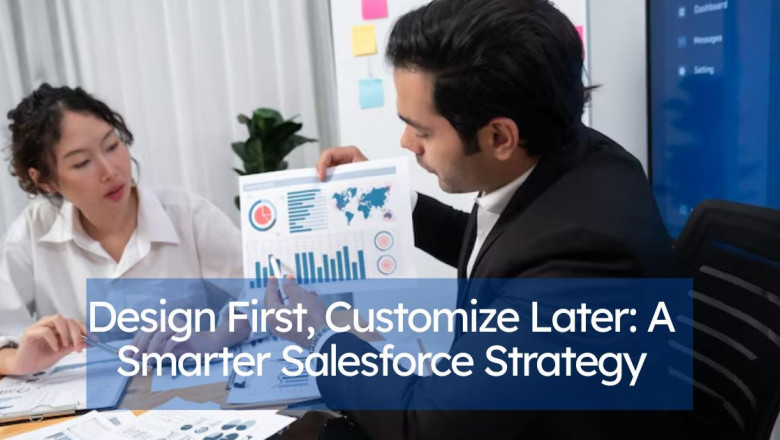views
Design First, Customize Later: A Smarter Salesforce Strategy
In the fast-paced world of digital transformation, Salesforce is the backbone of many business operations--streamlining sales, customer support, marketing automation, and beyond. When organizations rush to customize without a solid foundational design they end up with bloated, slow-performing systems and frustrated users. That’s why forward-thinking businesses are turning to Salesforce architecture consulting service providers to reimagine their implementation strategies.
What is the smarter way? Design first, customize later. This method ensures a scalable and maintainable Salesforce org, which not only meets the current business needs, but also grows with it. This blog will explore why design is always the first step in Salesforce customization and how this leads to smarter solutions that are future-ready.
1. The Problem with Customization-First Approaches
Salesforce is often used by companies to build custom objects, triggers, workflows and page layouts. This may seem productive initially, but it can lead to:
-
Over-customization of standard functionality.
-
Inconsistencies in data models causing issues with reporting and integration.
-
Technical debt is high and difficult to maintain or reverse.
-
A cluttered and non-intuitive user interface can cause confusion.
It can be likened to building a home without blueprints, which may look beautiful on the surface but is structurally unsound.
2. What Does “Design First” Mean in Salesforce?
Prior to development, design-first thinking focuses on planning, scalability and alignment. It involves:
-
Define business processes clearly.
-
Before creating custom Salesforce functionality, evaluate the standard capabilities.
-
Data mapping, access control and automation strategy.
-
Design with growth in mind.
This is usually led by Salesforce consultants or architects who are familiar with the capabilities of the platform and the long-term goals of the company.
3. Benefits of the Design-First Approach
🔹 a. Better Scalability
Salesforce systems that are well-designed can handle future needs with ease. Your CRM structure will remain strong as your company grows. You'll need less rework.
🔹 b. Faster Time-to-Market
Spending time on design can actually speed up delivery. A well-defined blueprint will help you avoid costly revisions or errors in development.
🔹 c. Lower Maintenance Cost
You can reduce code complexity and redundancy by using a thoughtful design. This results in easier maintenance, faster updates, and fewer defects.
🔹 d. Enhanced User Experience
Users are more likely to adopt a platform when workflows, page layouts and automations are logically structured. They can spend more time on productive tasks and less time trying to figure out how things work.
4. Key Elements of a Strong Salesforce Design
✅ Data Model Design
Identify entities, and their relationships. Standard objects (e.g. Accounts, Contacts and Opportunities) should be used whenever possible. Custom objects are only introduced when necessary.
✅ Security and Access Control
Clarify user roles, permission sets, and profiles. Avoid profiles that are "one size fits all" and create security or compliance risks.
✅ Automation Strategy
Early on, decide between Apex triggers and flows. For performance and maintenance, it is best to use a single automation layer for each object.
✅ Integration Planning
Consider the data flow that will occur if external systems are involved. Real-time or batch? Batch? What happens if the integration fails?
✅ UI/UX Design
Keep it tidy. Avoid overwhelming users with unnecessary fields, tabs or information. Use Lightning Pages to group related data and make the most of them.
5. When to Customize (And When Not To)
Salesforce's features out of the box are vast and underutilized. Always ask yourself:
-
Can this be met by a standard feature?
-
Does an AppExchange application that solves this issue?
-
Is it easy to modify or scale this design later?
Custom development should only be considered when there is a "no" from all parties. Even then, the plan should guide it.
6. Real-World Example: Two Paths, Two Outcomes
Imagine that two companies implement Salesforce for sales automation.
-
Company A dives straight into customization. They create custom fields, workflows, and triggers without analysing their actual sales processes. They face duplicate data within six months. Users complain and maintenance costs rise.
-
On the other hand Company B engages a Salesforce Architect to design its data model, user flow, and automation plan. They rely on standard features, and only introduce a few customized elements. The system is easy to scale, their implementation is seamless, and adoption is high.
What is the difference? Design-first thinking.
Conclusion
Salesforce is an incredibly powerful platform, but with that power comes responsibility. Your system will remain clean, efficient and ready for growth with a thoughtful design process. You can protect your investment by resisting the temptation to customize the platform immediately.
It's time to rethink strategy if your organization plans to implement Salesforce or is trying to detangle a muddled org. It is best to hire salesforce architect who are experts in scalable architecture and structured design to ensure success over the long term.






















Comments
0 comment